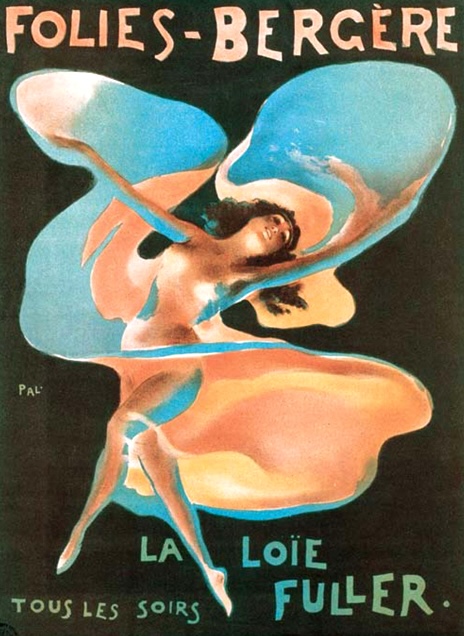Count Taylor Swift and Shakira as Fans of Dancer Loïe Fuller, Subject of a New Documentary
‘Obsessed With Light’ is a meditation on artistic continuity, of how the past continues to inform and inspire the present. This is a lesson that always bears repeating, particularly in an era as ahistorical as our own.

New Yorkers who regularly traverse the byways of Penn Station may not know the name Loïe Fuller (1862-1928), but they will recognize the distinctive figure she cut. Fuller’s “Serpentine Dance” was in regular circulation on the LED signage monitors situated throughout the building this fall as part of an advertising campaign by the Museum of Modern Art. That delicately tinted vignette of a woman twirling extravagant lengths of silk? She’s Fuller.
Or, rather, this was the dance she invented in the earlier 1890s, and quite the international sensation it was. Upon introducing her act two years later at the Folies Bergère, the Illinois-born Fuller became the doyenne of Paris and, in particular, its demimonde.
Poets such as Stéphane Mallarmé and W.B. Yeats waxed metaphorical about her virtues. The former described how Fuller embodied a “virginity of un-dreamt of places”; the latter likened her loose-limbed choreography to “a dragon of air … on its own furious path.”
The sculptor Auguste Rodin was a friend, as was the physicist Marie Curie. Henri Toulouse-Lautrec immortalized Fuller in a lithograph that was audacious bordering on abstract; James Abbott McNeil Whistler rendered her movements in a series of sinuous gesture drawings. “La fée éléctricité” was no mean talent at marketing her celebrity, lending her name to soap, her physique to decorative figurines and her image to the pioneering filmmakers Georges Méliès and the Lumière brothers.

Then there were the imitators who flattered Fuller to widespread and consternating effect. Filmmakers Zeva Oelbaum and Sabine Krayenbühl, whose documentary, “Obsessed With Light,” is set to open this Friday at Quad Cinema, highlight Fuller’s myriad imitators. These include Annabelle Moore, one of many who took Fuller’s signature routine and ran with it.
The filmmakers also mention the legal and financial travails she went through in the pursuit of copyrighting the “Serpentine Dance.” How successful was Fuller in dealing with these issues? Ms. Oelbaum and Ms. Krayenbühl only glance upon the answers, which will be frustrating for those eager to learn more about her. But, then, we are told that this isn’t a “bio-pic.”
“Obsessed With Light” is, instead, a meditation on artistic continuity, of how the past continues to inform and inspire the present. This is a lesson that always bears repeating, particularly in an era as ahistorical as our own. Much of the film is devoted to how Fuller has been embraced by a host of contemporary creative types. The pop singer Shakira is a fan, as is the inescapable Taylor Swift, who considers Fuller “a pioneer in the arts, dance, and design and who fought for artists to own their own work.”
Neither Shakira nor Ms. Swift are among the talking heads we encounter in “Obsessed With Light,” but we do hear from choreographer Bill T. Jones, director and playwright Robert Wilson, and multi-media artist William Kentridge. We learn about the artist’s influence on fashion, lighting design, performance art, dance, and body positivity. Fuller, you see, wasn’t in possession of a typical dancer’s body. In the words of one of her collaborators, designer Clara Driscoll of Tiffany Studios, Fuller was a “little, fat, dumpy, short-necked woman with most insignificant and plain little features.”
She was also driven, ambitious, and terrible with money. Debt is a recurring motif of Cherry Jones’s voiceover narration, the text of which was culled largely from Fuller’s autobiography, “Fifteen Years of a Dancer’s Life.” Would that Ms. Oelbaum and Ms. Krayenbühl had spent more time filling out the complications and contours of that life, particularly given the quality of the archival prints with which they pepper their film. The contemporary voices add ballast, but the corresponding artworks seem dim in contrast to the eccentricities and doggedness of Fuller herself. She’s a performer worth getting to know more fully.

